
Emus and other ratites possess a level of anatomical distinctiveness that may surprise you. From their skeletal structure to immune system responses, the differences are not only intriguing but also crucial in understanding their evolutionary paths.
As you explore the comparative anatomy of these unique flightless birds, be prepared to uncover how their adaptations have enabled them to thrive in diverse environments and carve out their place in the natural world.
Key Takeaways
- Emus exhibit specialized skeletal adaptations for bipedal locomotion.
- Emus possess efficient cardiovascular systems with large hearts and optimized oxygen delivery.
- Emus display unique neural and sensory adaptations for survival and environmental awareness.
- Emus showcase protective systems like integumentary adaptations and tailored immune responses.
Skeletal Structure Comparison
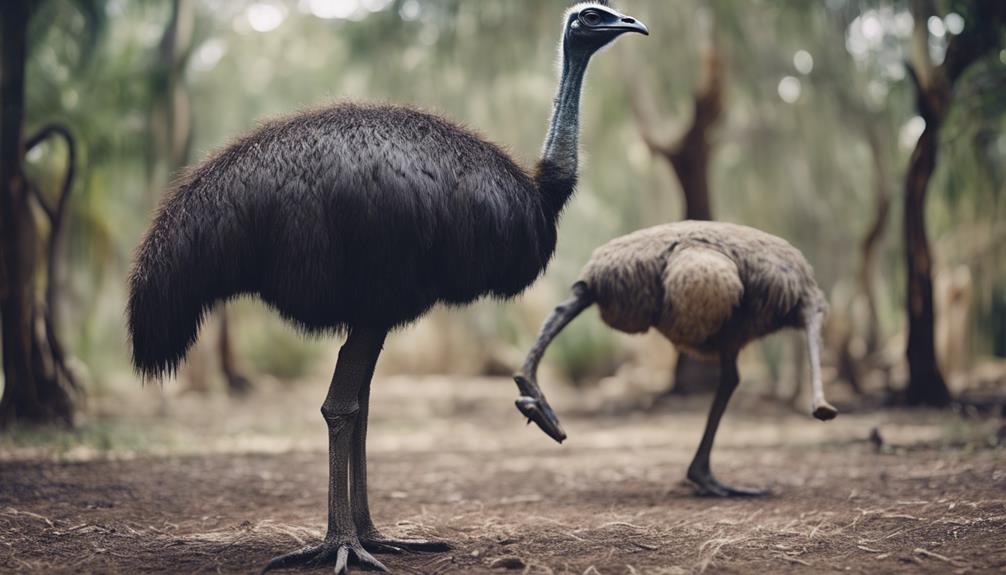
When comparing the skeletal structures of emus and other ratites, it becomes evident that their adaptations for bipedal locomotion are strikingly similar yet exhibit subtle variations in specific bone proportions. Emus, like other ratites, have evolved specialized skeletal features to support their unique locomotion patterns. The development of their skeletal structure is intricately linked to their bipedal lifestyle.
In the case of emus, their long, robust leg bones provide the necessary support for efficient bipedal movement. The elongated tarsometatarsus, a fusion of foot and ankle bones, enhances the leverage needed for powerful strides. This skeletal adaptation is crucial for maintaining balance and stability during rapid running.
Furthermore, the pelvic girdle of emus displays modifications optimized for their bipedal locomotion. The ilium, ischium, and pubis bones are arranged in a manner that maximizes strength and flexibility while minimizing weight. These subtle variations in skeletal proportions highlight the intricate relationship between skeletal structure development and locomotion patterns in emus and other ratites.
Muscular System Variations
The muscular system variations between emus and other ratites exhibit distinct adaptations tailored to their specific locomotion requirements. Emus, known for their swift running abilities, possess unique muscle fiber composition that enhances their locomotion efficiency. Here's a closer look at how their muscular systems differ:
- Muscle Fiber Types: Emus have a higher proportion of fast-twitch muscle fibers compared to other ratites, allowing for quick bursts of speed during running.
- Leg Musculature: Emus have well-developed leg muscles, particularly in the thigh and calf regions, providing the power needed for their strong strides.
- Wing Muscles: Unlike flighted birds, emus have reduced wing muscles, as they don't rely on flight for locomotion.
- Neck Muscles: Emus have robust neck muscles that support their long neck and aid in balance while running at high speeds.
These adaptations in muscle structure contribute to the remarkable locomotion efficiency of emus, enabling them to thrive in their natural habitats.
Cardiovascular System Adaptations
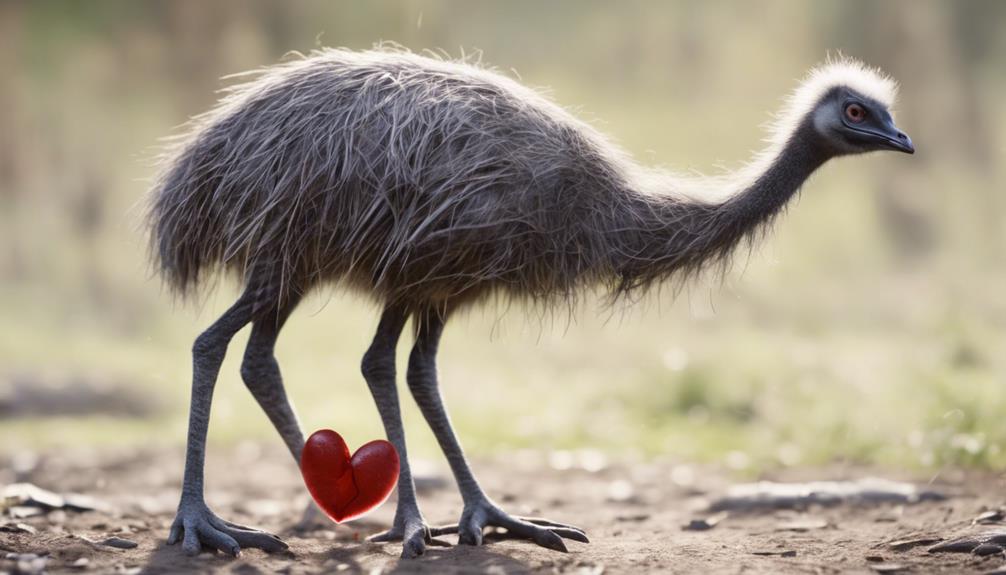
Cardiovascular adaptations in emus and other ratites reveal specialized features that optimize oxygen delivery during their unique modes of locomotion. The circulatory system efficiency in these flightless birds is finely tuned to support their demanding physical activities. Emus, ostriches, and other ratites have large hearts relative to their body size, allowing for increased blood pumping capacity. This adaptation ensures adequate oxygen supply to muscles during activities like running or swimming. Additionally, their arteries and veins are structured to minimize resistance to blood flow, enhancing overall cardiovascular performance.
Compared to flying birds, ratites have a lower heart rate but higher stroke volume, meaning that with each beat, more blood is ejected into circulation. This results in a more efficient oxygen delivery system, crucial for sustaining endurance during prolonged locomotion. The unique cardiovascular system adaptations in emus and other ratites showcase evolutionary modifications that cater to their specific needs, emphasizing the intricate balance between energy expenditure and oxygen utilization in these fascinating creatures.
Respiratory System Differences
Amidst the physiological distinctions between emus and other ratites, notable variations in their respiratory systems emerge, delineating crucial differences in oxygen uptake and utilization strategies. Emus have evolved specific adaptations in their respiratory system to enhance efficiency and support their high-energy demands.
Here are some key points to help you understand these differences:
- Air Sacs: Emus possess a complex system of air sacs that aid in the unidirectional flow of air through their lungs, maximizing oxygen exchange efficiency.
- Tracheal Elongation: Unlike other ratites, emus have an elongated trachea that allows for increased airway dead space, contributing to improved respiratory efficiency.
- High Lung Compliance: Emus exhibit higher lung compliance, enabling them to efficiently regulate air movement and optimize gas exchange during both rest and strenuous activities.
- Diaphragmatic Function: Emus rely heavily on their diaphragm for respiration, showcasing a unique mechanism that enhances their respiratory efficiency compared to other ratites.
Digestive Tract Anatomy
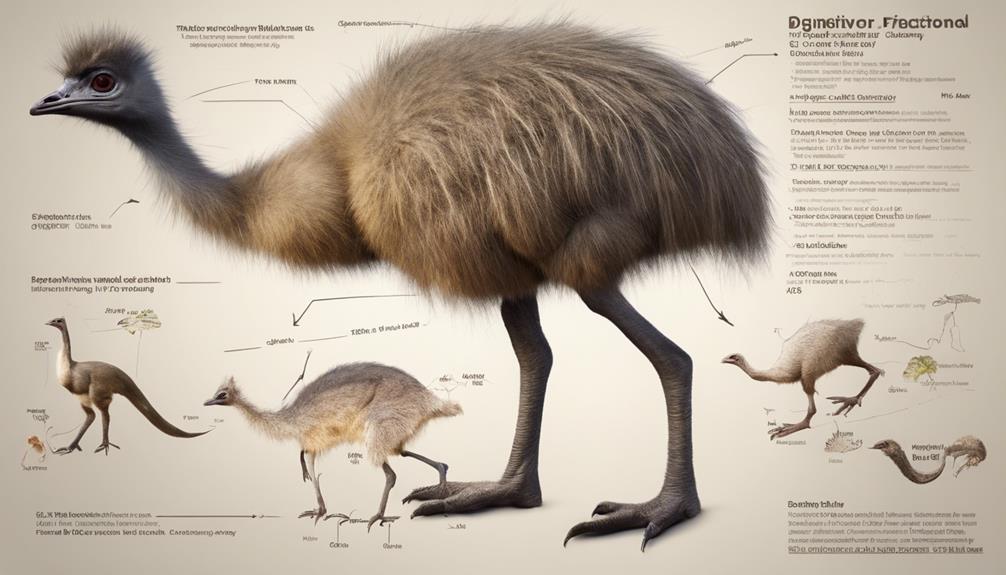
Emus and other ratites display distinct anatomical features in their digestive tracts that play pivotal roles in nutrient processing and absorption efficiency. The unique structure of the emu digestive system contributes to its remarkable digestion efficiency, allowing them to extract maximum nutrients from their plant-based diet. One key factor influencing this efficiency is the composition of the ratite gut microbiome, a complex ecosystem of microorganisms that aid in breaking down tough plant fibers and enhancing nutrient absorption.
| Digestive Tract Feature | Emus | Other Ratites |
|---|---|---|
| Cecum Size | Large | Small |
| Stomach Capacity | Moderate | Variable |
| Intestinal Length | Long | Short |
| Crop Presence | Present | Absent |
Emus have a relatively larger cecum compared to other ratites, which assists in the fermentation of plant material. Their elongated intestinal tract allows for more extended contact time between food and digestive enzymes, maximizing nutrient absorption. The presence of a crop in emus aids in food storage and initial breakdown. These digestive adaptations highlight the intricate relationship between anatomy and digestion efficiency in emus and other ratites.
Reproductive Organ Variances
Reproductive organ variances in emus and other ratites exhibit notable differences in structure and functionality that underpin their distinct reproductive strategies. Emus, for example, possess a unique elongated structure in their reproductive system that aids in the internal fertilization process, setting them apart from other ratites.
Here are some key differences to consider:
- Hormonal Regulation: Emus have a complex hormonal regulation system that controls their reproductive cycle, ensuring optimal conditions for successful fertilization.
- Fertilization Process: Unlike some ratites, emus have specialized reproductive organs that allow for internal fertilization, increasing the chances of successful reproduction.
- Reproductive Tract Structure: The reproductive tract of emus is intricately designed to support the fertilization process, with each part playing a crucial role in ensuring successful reproduction.
- Egg Development: Emus exhibit a unique egg development process that's closely tied to their reproductive system's functionality, showcasing the intricate interplay between hormonal regulation and fertilization.
These variances highlight the fascinating adaptations that have evolved in emus to support their reproductive success.
Nervous System Features

In the intricate anatomy of ratites, particularly in the realm of comparative anatomy, the nervous system features stand out as crucial components that contribute significantly to their physiological functioning. When comparing Emus and other ratites, the complexity of the brain and the distribution of neurons play a vital role in understanding their behaviors and cognitive abilities. Emus exhibit a well-developed brain with specialized regions for processing various sensory inputs, enabling them to adapt to their environments effectively. Additionally, the organization of the spinal cord in Emus is optimized for efficient reflex pathways, allowing for rapid responses to stimuli. This intricate nervous system architecture is what enables Emus to thrive in diverse habitats and exhibit behaviors essential for their survival.
| Nervous System Features | Emus | Other Ratites |
|---|---|---|
| Brain Complexity | Well-developed | Varies among species |
| Neuron Distribution | Specialized regions | Differ in distribution |
| Spinal Cord Organization | Efficient reflex paths | Adapted to environment |
Sensory Organ Characteristics
Comparing the sensory organ characteristics of Emus and other ratites reveals intricate adaptations that enhance their perception and interaction with their environments. When examining these features, you find that:
- Olfactory capabilities: Emus possess a keen sense of smell, aiding in foraging and detecting predators. This is a crucial survival advantage in their habitats.
- Visual acuity: Their eyes are adapted for excellent long-distance vision, allowing them to spot potential threats or food sources from afar with remarkable clarity.
- Auditory sensitivity: Emus have well-developed hearing, enabling them to detect subtle sounds in their surroundings, which is vital for communication and avoiding danger.
- Tactile receptors: Their skin is equipped with specialized receptors that enhance their ability to feel and respond to touch, crucial for social interactions and environmental awareness.
These sensory adaptations reflect the evolutionary paths taken by Emus and other ratites to thrive in their respective ecosystems, highlighting the intricate balance between perception and survival in the natural world.
Endocrine System Varied Functions
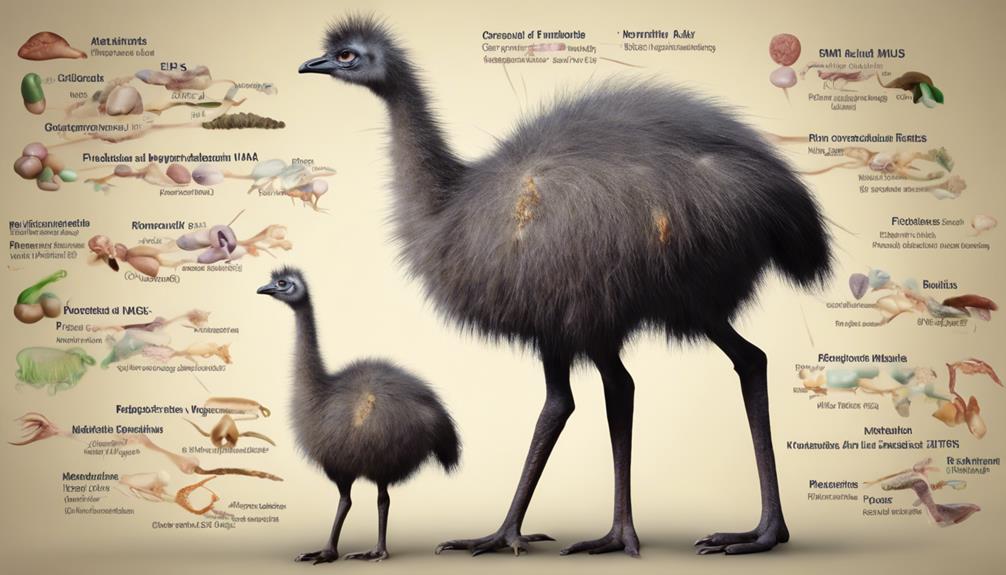
Examining the endocrine system functions in Emus and other ratites reveals a diverse array of hormonal processes that play pivotal roles in regulating various physiological functions essential for their survival and adaptation to their environments.
Hormonal regulation in these birds is crucial for maintaining homeostasis, growth, metabolism, and reproduction. The endocrine system of ratites, including Emus, involves intricate interactions between different glands such as the pituitary, thyroid, and adrenal glands, which secrete hormones like corticosteroids, thyroid hormones, and growth factors.
These glandular secretions coordinate responses to stress, regulate energy levels, and influence molting and breeding behaviors. Interestingly, the endocrine system in Emus exhibits certain adaptations compared to other ratites, possibly due to their specific environmental and evolutionary pressures. Understanding these endocrine adaptations provides insights into how Emus and other ratites have evolved to thrive in diverse habitats and cope with changing conditions.
The intricate web of hormonal signaling within their endocrine systems highlights the remarkable complexity and efficiency of these avian species in maintaining physiological balance and responding to external challenges.
Integumentary System Variances
The intricate hormonal interactions observed in Emus and other ratites extend their influence beyond the endocrine system, revealing notable variances in the integumentary system structure and function. These differences are particularly evident in the mechanisms of feather development and skin adaptations. When comparing Emus with other ratites, the following variations come to light:
- Feather Development: Emus exhibit a unique feather growth pattern, with specialized down feathers intermingled with long, coarse feathers, providing insulation and protection against environmental elements.
- Skin Adaptations: Emus possess specialized skin adaptations such as sweat glands that aid in thermoregulation, allowing them to thrive in diverse habitats.
- Feather Distribution: The distribution of feathers on Emus differs from other ratites, with specific arrangements that enhance their aerodynamics and agility.
- Skin Pigmentation: The skin pigmentation in Emus serves as a protective mechanism against harmful UV radiation, showcasing their adaptation to sun-exposed environments.
Understanding these integumentary system variances sheds light on the unique evolutionary adaptations that have shaped Emus and other ratites.
Immune System Responses
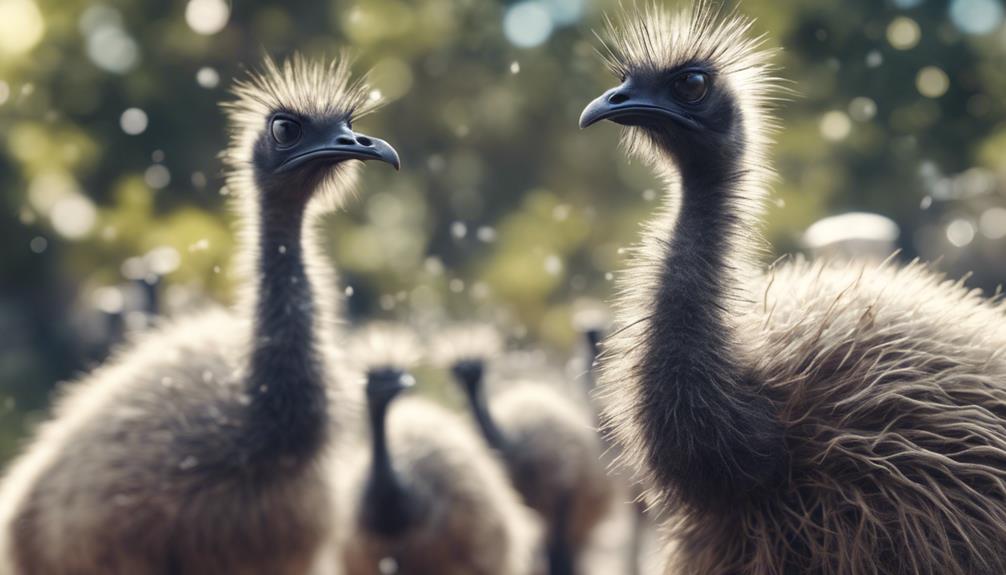
Amidst the diverse anatomical adaptations observed in Emus and other ratites, the immune system responses exhibit intricate mechanisms tailored to their environmental challenges. The efficiency of immune responses in Emus and other ratites is influenced by genetic factors that have evolved over time. These genetic variations play a crucial role in determining the speed and effectiveness of their immune defenses against pathogens.
In terms of inflammatory cytokine regulation, Emus and other ratites have developed specific mechanisms to control the inflammatory response. This regulation is vital to prevent excessive inflammation that could harm the host while still effectively combating pathogens. Additionally, their immune systems have evolved sophisticated pathways for pathogen recognition, allowing them to identify and respond to a wide range of invading microorganisms efficiently.
Evolutionary Adaptations
Evolutionarily adapting to diverse environments has led Emus and other ratites to develop specialized anatomical features that enhance their survival and reproductive success. When comparing their evolutionary adaptations, you can observe fascinating differences that have emerged due to their distinct behavioral ecology and environmental niche requirements:
- Foraging Behavior: Emus, with their elongated necks and sharp beaks, have evolved for efficient ground-level foraging, while ostriches exhibit a preference for browsing on shrubs and trees due to their taller stature.
- Thermoregulation Strategies: Rhea species have developed unique feather structures that aid in both insulation during cold temperatures and heat dissipation in hot climates.
- Leg Structure: Cassowaries possess powerful legs with sharp claws, adapted for swift movement through dense vegetation, contrasting with the more cursorial leg structure of the ostrich for open savannas.
- Reproductive Patterns: Kiwis, known for their nocturnal habits, have evolved reduced wings, indicating their shift towards a more ground-based lifestyle compared to the other diurnal ratites.
These adaptations highlight the intricate interplay between behavioral ecology comparisons and environmental niche differences in shaping the anatomical diversity among ratites.
Frequently Asked Questions
How Do Emus and Other Ratites Communicate With Each Other?
When emus and other ratites communicate, they rely on a combination of vocalizations, body language, visual signals, and scent marking. Through these methods, they convey messages, establish hierarchies, and maintain social bonds within their groups.
Are Emus and Other Ratites Able to Swim?
You might be surprised to learn that emus and other ratites, like ostriches and kiwis, are not strong swimmers. Their aquatic abilities are limited due to their lack of water adaptations and buoyancy.
What Is the Average Lifespan of Emus Compared to Other Ratites?
Emus typically live around 10-20 years, while other ratites like ostriches can reach 30-40 years. This lifespan comparison showcases varying longevity among ratites, influenced by factors such as environment, predation, and overall health.
Do Emus and Other Ratites Have Any Unique Behaviors or Social Structures?
Exploring the fascinating world of emus and other ratites reveals intricate breeding habits and complex group dynamics. Their mating rituals and social hierarchies showcase a blend of instinct and learned behavior, offering insights into their unique ways of interaction.
Are There Any Cultural or Historical Significance Associated With Emus and Other Ratites in Different Societies?
In various societies, emus and other ratites hold cultural beliefs and historical significance. They are woven into rituals, legends, and traditions, symbolizing different meanings and values unique to each community's worldview and heritage.
Conclusion
You have now explored the intricate comparative anatomy of emus and other ratites, delving into the skeletal structure, muscular system, cardiovascular system, respiratory system, digestive tract, endocrine system, integumentary system, immune system, and evolutionary adaptations.
By uncovering these differences and similarities, you have gained a deeper understanding of the unique features that have allowed these fascinating birds to thrive in their respective environments.
Keep exploring and learning about the wonders of the natural world!





